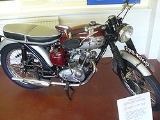
Triumph Tiger Cub
Encyclopedia
The Triumph Tiger Cub is British motorcycle
made by Triumph Motorcycles at their Meriden
factory. Designed by Edward Turner
and launched at the Earls Court
show in November 1953 the Tiger Cub competed well against the other small capacity motorcycles of the time such as Villiers
two-strokes.
and fork
s. In 1957 an off-road version the T20C was produced with high level exhaust and improved suspension. The original model had a plunger frame but this was changed to the modern pattern of swinging fork and two suspension units in 1957. The original model also had the ignition points in a "distributor" on the crankcase behind the cylinder, later models (such as the one shown) have it at a more regular location, on the end of the camshaft under a chrome cover. The last model made was the T20B Super Cub, which was a D10 Bantam with a Cub engine. Launched in November 1966, it was discontinued in 1968.
Motorcycle
A motorcycle is a single-track, two-wheeled motor vehicle. Motorcycles vary considerably depending on the task for which they are designed, such as long distance travel, navigating congested urban traffic, cruising, sport and racing, or off-road conditions.Motorcycles are one of the most...
made by Triumph Motorcycles at their Meriden
Meriden, West Midlands
-External links:*****...
factory. Designed by Edward Turner
Edward Turner
Edward Turner was a British motorcycle designer. He was born in Camberwell in the London Borough of Southwark, on the day King Edward VII was proclaimed King....
and launched at the Earls Court
Earls Court
Earls Court is a district in the Royal Borough of Kensington and Chelsea in London, England. It is an inner-city district centred on Earl's Court Road and surrounding streets, located 3.1 miles west south-west of Charing Cross. It borders the sub-districts of South Kensington to the East, West...
show in November 1953 the Tiger Cub competed well against the other small capacity motorcycles of the time such as Villiers
Villiers
-Places:In Canada* Villiers, Ontario, a small settlement near PeterboroughIn France* Villiers, Indre, in the Indre département* Villiers, Vienne, in the Vienne département* Villiers-Adam, in the Val-d'Oise département...
two-strokes.
Development
The first Tiger Cub was derived from the Triumph Terrier with the same frameMotorcycle frame
A motorcycle frame includes the head tube that holds the front fork and allows it to pivot. Some motorcycles include the engine as a load-bearing, stressed member. The rear suspension is an integral component in the design. Traditionally frames have been steel, but titanium, aluminium, magnesium,...
and fork
Motorcycle fork
A motorcycle fork connects a motorcycle's front wheel and axle to its frame, typically via a pair of triple clamps. It typically incorporates the front suspension and front brake, and allows the bike to be steered via handlebars attached to the top clamp....
s. In 1957 an off-road version the T20C was produced with high level exhaust and improved suspension. The original model had a plunger frame but this was changed to the modern pattern of swinging fork and two suspension units in 1957. The original model also had the ignition points in a "distributor" on the crankcase behind the cylinder, later models (such as the one shown) have it at a more regular location, on the end of the camshaft under a chrome cover. The last model made was the T20B Super Cub, which was a D10 Bantam with a Cub engine. Launched in November 1966, it was discontinued in 1968.

